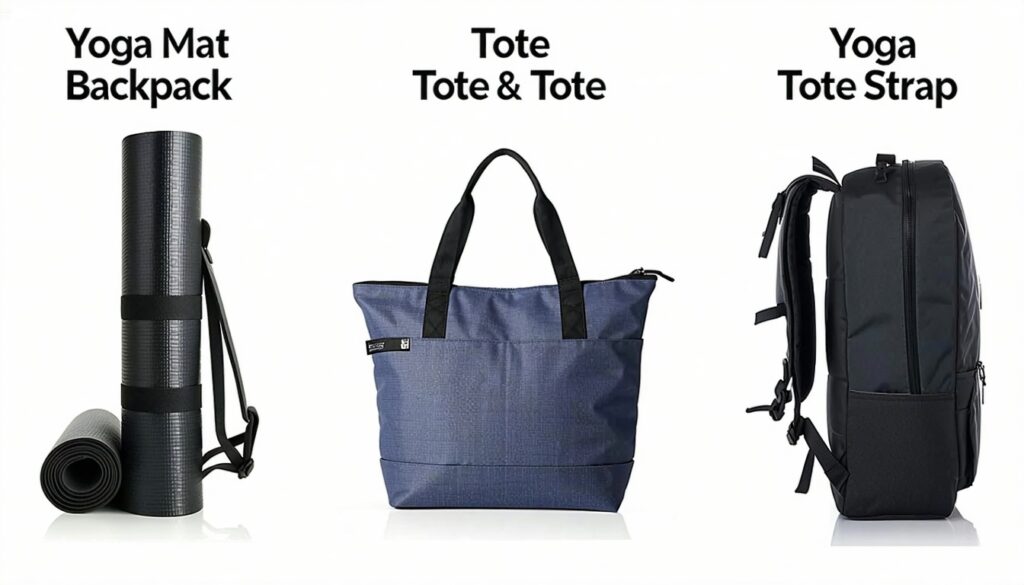Yoga Mat Backpack vs Tote vs Strap: Which One Wins?

Choosing the Right Yoga Bag
Selecting the right yoga bag is essential for health-conscious individuals who regularly practice yoga. The right bag not only provides functionality but also aligns with personal values, such as environmental consciousness and style.
Material Considerations
When choosing a yoga bag, the material plays a significant role in its durability, weight, and overall performance. Here are some common materials used in yoga bags:
| Material | Characteristics |
|---|---|
| Organic Cotton | Soft, breathable, hypoallergenic; grown without synthetic pesticides or fertilizers |
| Nylon | Durable, water-resistant, lightweight; withstands rough handling and adverse weather |
| Canvas | Sturdy, versatile, classic look; ideal for heavy loads and long-lasting use |
| Recycled Polyester | Eco-friendly option; combines durability with sustainability |
Choosing a bag made from natural materials like cotton or canvas can enhance breathability and comfort, while synthetic options like nylon offer resilience and water resistance.
Environmental Impact
The environmental impact of yoga bags is an important consideration for many yogis. Eco-friendly yoga mat bags made from materials like organic cotton and recycled polyester are designed to be durable while minimizing their ecological footprint.
Opting for bags that are produced sustainably not only supports the environment but also aligns with the values of health-conscious individuals. By choosing eco-friendly materials, one can contribute to reducing pollution and promoting sustainable practices in the yoga community.
For more insights on selecting the right yoga bag, check out our guide on how to choose the right yoga backpack for your practice.
Types of Yoga Bags
When it comes to carrying yoga gear, there are several types of bags available, each with its own unique features and benefits. Understanding the differences can help health-conscious individuals choose the best option for their needs. Here are three popular types of yoga bags: sling bags, backpacks, and tote bags.
Sling Bags
Sling bags are designed to be lightweight and easy to carry. They typically feature a single strap that can be worn over the shoulder or across the body. This design makes them perfect for those who need to transport their mat to and from the studio without any extra bulk.
| Pros | Cons |
|---|---|
| Lightweight and compact | Limited storage space |
| Easy to carry | May not fit additional gear |
| Stylish options available | Less comfortable for long distances |
Backpacks
Backpacks offer a more balanced way to carry yoga mats and other essentials. With two straps, they distribute weight evenly across the shoulders, making them ideal for longer commutes or for those who carry additional gear like water bottles, towels, and yoga blocks.
| Pros | Cons |
|---|---|
| Comfortable for longer distances | Can be bulkier than other options |
| Ample storage for gear | May require more space when not in use |
| Often includes multiple compartments | Heavier when fully loaded |
Tote Bags
Tote bags are versatile and stylish, often featuring open tops and spacious interiors. They are great for yogis who want a bag that can double as a regular tote for everyday use. These bags usually come with additional pockets and compartments, making it easy to organize belongings.
| Pros | Cons |
|---|---|
| Stylish and fashionable | Less secure than other options |
| Spacious interior for various items | May not have specific compartments for yoga gear |
| Easy to access items | Can become heavy when loaded |
Choosing the right type of yoga bag depends on individual preferences and needs. For more information on selecting the best option, check out our guide on how to choose the right yoga backpack for your practice.
Benefits of Yoga Mat Bags
Yoga mat bags offer numerous advantages for health-conscious individuals who regularly practice yoga. These bags not only enhance the overall experience but also contribute to the longevity of yoga gear.
Cleanliness and Hygiene
A yoga mat bag plays a crucial role in maintaining the cleanliness and hygiene of the mat. By keeping the mat away from dust, dirt, and moisture, these bags ensure that it remains clean and ready for use. Bags made from waterproof materials like nylon or polyester are particularly effective in keeping the mat dry, which is essential for a healthy practice.
Additionally, a bag protects the mat from damage, preventing it from getting scuffed, torn, or squashed. This protection ultimately extends the lifespan of the mat, saving money on replacements.
| Benefit | Description |
|---|---|
| Keeps mat clean | Protects from dust and dirt |
| Waterproof options | Ensures mat stays dry |
| Prevents damage | Reduces risk of scuffs and tears |
Organization and Convenience
Yoga mat bags also aid in organization by offering extra compartments for storing accessories like blocks, straps, towels, water bottles, keys, or phones. These compartments help keep everything organized, allowing for quick access to belongings without the hassle of digging through the bag.
A well-organized bag reduces clutter and stress, making the yoga routine smoother and more enjoyable. Many brands even offer bundles that include both the mat and the bag, providing a cost-effective solution for those looking to invest in quality gear.
| Feature | Benefit |
|---|---|
| Extra compartments | Store accessories efficiently |
| Quick access | Reduces time spent searching |
| Cost-effective bundles | Save money on combined purchases |
By investing in a quality yoga mat bag, practitioners can enhance their yoga experience while ensuring their gear remains in top condition. For more tips on selecting the right bag, check out our guide on how to choose the right yoga backpack for your practice.
Factors to Consider in Yoga Mat Backpacks
When selecting a yoga mat backpack, several key factors can enhance the overall experience for health-conscious individuals who regularly practice yoga. These factors include durability, water resistance, and comfortable straps.
Durability
Durability is a crucial aspect of any yoga mat backpack. A well-constructed bag can withstand the rigors of daily use, including rough handling and exposure to various weather conditions. Nylon yoga bags are particularly favored for their durability, water resistance, and lightweight nature, making them suitable for active lifestyles.
| Material | Durability | Water Resistance | Weight |
|---|---|---|---|
| Nylon | High | Yes | Lightweight |
| Polyester | Moderate | Yes | Moderate |
| Canvas | Moderate | No | Heavy |
Water Resistance
Water resistance is another essential feature to consider in a yoga mat backpack. Keeping belongings dry during unexpected rain or spills is vital. Opt for materials like treated nylon or polyester, which offer water-resistant properties. Additionally, look for backpacks with sealed zippers and extra waterproof features, such as rain covers or water-resistant linings.
| Feature | Description |
|---|---|
| Treated Nylon | Offers excellent water resistance |
| Sealed Zippers | Prevents water from entering the bag |
| Rain Covers | Provides extra protection during heavy rain |
Comfortable Straps
Comfortable straps are essential for a yoga mat backpack, especially for those who carry additional gear like water bottles, towels, and yoga blocks. Look for padded, adjustable, and breathable straps that distribute weight evenly across the shoulders. This design helps reduce pressure points and prevents discomfort during commutes or travel.
| Strap Feature | Benefits |
|---|---|
| Padded Straps | Reduces pressure on shoulders |
| Adjustable Length | Customizes fit for comfort |
| Breathable Material | Enhances airflow and reduces sweat |
By considering these factors, individuals can choose a yoga mat backpack that meets their needs for durability, water resistance, and comfort. For more insights on selecting the right yoga backpack, check out our guide on how to choose the right yoga backpack for your practice.
Features of a Quality Yoga Mat Backpack
When selecting a yoga mat backpack, certain features can significantly enhance the user experience. Two of the most important features to consider are multiple compartments and a lightweight design.
Multiple Compartments
A well-designed yoga mat backpack should have multiple compartments to ensure organization and convenience. This feature allows users to store their yoga gear efficiently, making it easy to access items when needed.
| Compartment Type | Purpose |
|---|---|
| Main Compartment | Holds the yoga mat and larger items |
| Small Pockets | Ideal for keys, phones, and wallets |
| Side Pockets | Perfect for water bottles or yoga props |
Having designated spaces for different items helps prevent clutter and makes it easier to find essentials quickly. Look for backpacks that include a main compartment, small pockets for valuables, and side pockets for hydration.
Lightweight Design
A lightweight design is crucial in a yoga mat backpack to minimize strain on the shoulders and back. Materials such as nylon or polyester are excellent choices, as they offer both durability and lightness.
| Material | Benefits |
|---|---|
| Nylon | Strong, lightweight, and water-resistant |
| Polyester | Durable, lightweight, and easy to clean |
Proper weight distribution is essential for comfort. A well-constructed backpack with multiple compartments can enhance comfort without adding unnecessary weight (Yune Yoga).
Choosing a yoga mat backpack with these features can significantly improve the experience of carrying yoga gear to classes, studios, or while traveling. For more insights on selecting the right backpack, check out our guide on how to choose the right yoga backpack for your practice.
Selecting the Perfect Yoga Mat Strap
Choosing the right yoga mat strap can significantly enhance the convenience and comfort of transporting yoga gear. This section will cover the material choices and the importance of adjustability and comfort in selecting a yoga mat strap.
Material Choices
Yoga mat straps come in various materials, each offering unique benefits. The choice between natural and synthetic materials can impact durability, comfort, and environmental considerations.
| Material Type | Description | Pros | Cons |
|---|---|---|---|
| Natural (e.g., cotton, jute) | Soft and eco-friendly options | Comfortable feel, biodegradable | May wear out faster than synthetics |
| Synthetic (e.g., nylon, polyester) | Strong and durable materials | Resilient, withstands tension | Less eco-friendly, can be less comfortable |
Natural materials provide a softer touch and are often more environmentally friendly. In contrast, synthetic materials like nylon are known for their strength and durability, making them ideal for regular use. When selecting a strap, consider how the material aligns with personal preferences and values, including sustainability.
Adjustability and Comfort
When choosing a yoga mat strap, adjustability and comfort are crucial factors. A strap that can be easily adjusted ensures that it fits well regardless of the user’s height or carrying preference. This feature enhances the overall experience of transporting the mat, making it more convenient and comfortable.
Key considerations for adjustability and comfort include:
- Length: The strap should be long enough to accommodate different mat sizes and user heights.
- Ease of Use: Look for straps that can be adjusted quickly and easily, allowing for hassle-free setup.
- Padding: Some straps come with padding for added comfort, especially when carrying heavier mats.
A versatile strap can serve multiple functions beyond just carrying the mat, enhancing the overall yoga practice. Additionally, aesthetics and style can play a role in motivation, so selecting a strap that resonates with personal style can make the practice more enjoyable.
By considering material choices and the importance of adjustability and comfort, individuals can select the perfect yoga mat strap that meets their needs and enhances their yoga experience. For more information on choosing the right yoga backpack, check out our guide on how to choose the right yoga backpack for your practice.


